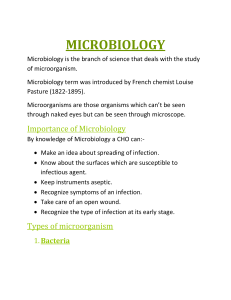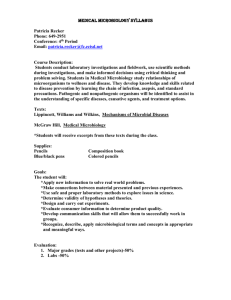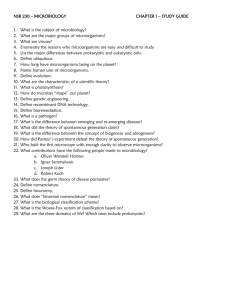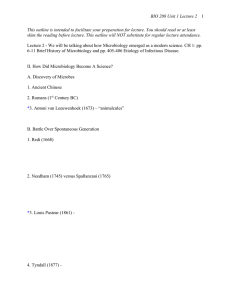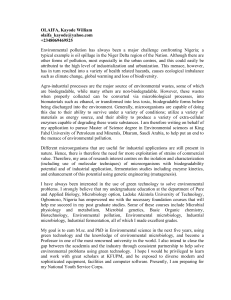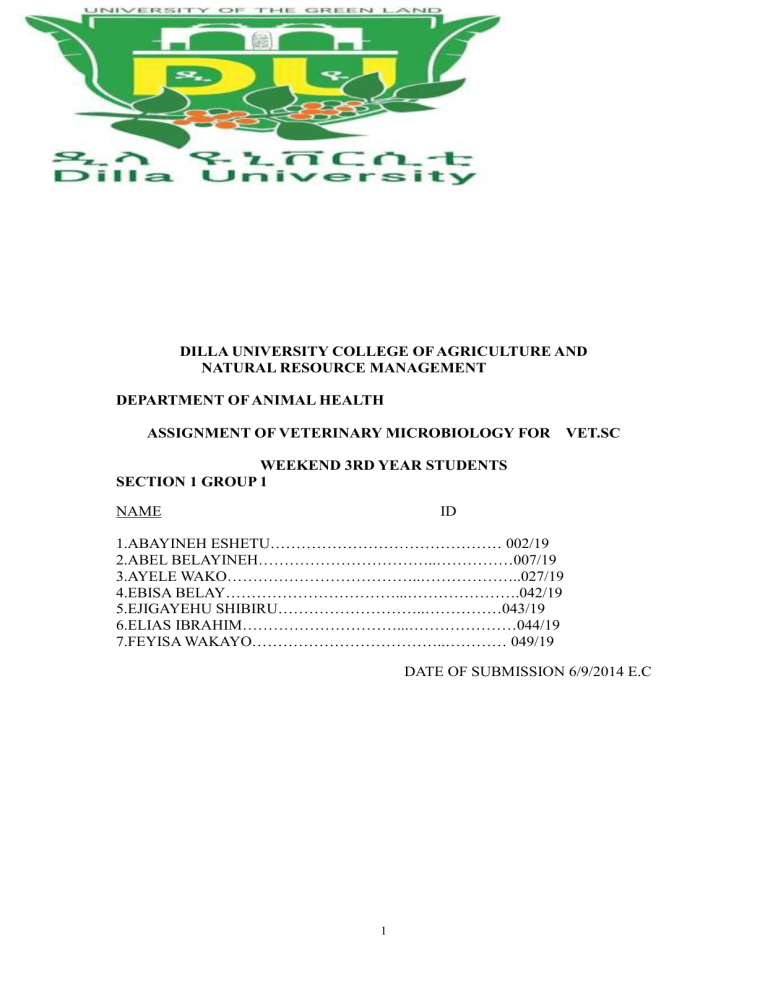
DILLA UNIVERSITY COLLEGE OF AGRICULTURE AND NATURAL RESOURCE MANAGEMENT DEPARTMENT OF ANIMAL HEALTH ASSIGNMENT OF VETERINARY MICROBIOLOGY FOR VET.SC WEEKEND 3RD YEAR STUDENTS SECTION 1 GROUP 1 NAME ID 1.ABAYINEH ESHETU……………………………………… 002/19 2.ABEL BELAYINEH……………………………..……………007/19 3.AYELE WAKO………………………………..………………..027/19 4.EBISA BELAY……………………………...………………….042/19 5.EJIGAYEHU SHIBIRU………………………..……………043/19 6.ELIAS IBRAHIM…………………………...…………………044/19 7.FEYISA WAKAYO………………………………..………… 049/19 DATE OF SUBMISSION 6/9/2014 E.C 1 1.write and discuss breifly about historical prospective and scope of microbiology ? A Brief History of Microbiology Microbiology has had a long, rich history, initially centered in the causes of infectious diseases but now including practical applications of the science. Many individuals have made significant contributions to the development of microbiology. Early history of microbiology. Historians are unsure who made the first observations of microorganisms, but the microscope was available during the mid‐1600s, and an English scientist named Robert Hooke made key observations. He is reputed to have observed strands of fungi among the specimens of cells he viewed. In the 1670s and the decades thereafter, a Dutch merchant named Anton van Leeuwenhoek made careful observations of microscopic organisms, which he called animalcules. Until his death in 1723, van Leeuwenhoek revealed the microscopic world to scientists of the day and is regarded as one of the first to provide accurate descriptions of protozoa, fungi, and bacteria. After van Leeuwenhoek died, the study of microbiology did not develop rapidly because microscopes were rare and the interest in microorganisms was not high. In those years, scientists debated the theory of spontaneous generation, which stated that microorganisms arise from lifeless matter such as beef broth. This theory was disputed by Francesco Redi, who showed that fly maggots do not arise from decaying meat (as others believed) if the meat is covered to prevent the entry of flies. An English cleric named John Needham advanced spontaneous generation, but Lazzaro Spallanzani disputed the theory by showing that boiled broth would not give rise to microscopic forms of life. Louis Pasteur and the germ theory. Louis Pasteur worked in the middle and late 1800s. He performed numerous experiments to discover why wine and dairy products became sour, and he found that bacteria were to blame. Pasteur called attention to the importance of microorganisms in everyday life and stirred scientists to think that if bacteria could make the wine “sick,” then perhaps they could cause human illness. Pasteur had to disprove spontaneous generation to sustain his theory, and he therefore devised a series of swan‐necked flasks filled with broth. He left the flasks of broth open to the air, but the flasks had a curve in the neck so that microorganisms would fall into the neck, not the broth. The flasks did not become contaminated (as he predicted they would not), and Pasteur's experiments put to rest the notion of spontaneous generation. 2 His work also encouraged the belief that microorganisms were in the air and could cause disease.Pasteur postulated the germ theory of disease, which states that microorganisms are the causes of infectious disease.Pasteur's attempts to prove the germ theory were unsuccessful. However, the German scientist Robert Koch provided the proof by cultivating anthrax bacteria apart from any other type of organism. He then injected pure cultures of the bacilli into mice and showed that the bacilli invariably caused anthrax.The procedures used by Koch came to be known as Koch's postulates.They provided a set of principles whereby other microorganisms could be related to other diseases. The development of microbiology. In the late 1800s and for the first decade of the 1900s, scientists seized the opportunity to further develop the germ theory of disease as enunciated by Pasteur and proved by Koch. There emerged a Golden Age of Microbiology during which many agents of different infectious diseases were identified. Many of the etiologic agents of microbial disease were discovered during that period, leading to the ability to halt epidemics by interrupting the spread of microorganisms. Despite the advances in microbiology, it was rarely possible to render life‐saving therapy to an infected patient.Then,after World War II, the antibiotics were introduced to medicine.The incidence of pneumonia, tuberculosis, meningitis, syphilis, and many other diseases declined with the use of antibiotics. Work with viruses could not be effectively performed until instruments were developed to help scientists see these disease agents. In the 1940s, the electron microscope was developed and perfected. In that decade, cultivation methods for viruses were also introduced, and the knowledge of viruses developed rapidly. With the development of vaccines in the 1950s and 1960s, such viral diseases as polio, measles, mumps, and rubella came under control. Modern microbiology. Modern microbiology reaches into many fields of human endeavor, including the development of pharmaceutical products, the use of quality‐control methods in food and dairy product production, the control of disease‐causing microorganisms in consumable waters, and the industrial applications of microorganisms. Microorganisms are used to produce vitamins, amino acids, enzymes, and growth supplements. They manufacture many foods, including fermented dairy products (sour cream, yogurt, and buttermilk), as well as other fermented foods such as pickles, sauerkraut, breads, and alcoholic beverages. One of the major areas of applied microbiology is biotechnology.In this discipline, microorganisms are used as living factories to produce pharmaceuticals that otherwise could not be manufactured.These substances include the human hormone insulin, the antiviral substance interferon, numerous blood‐clotting factors and clot dissolving enzymes, and a number of vaccines.Bacteria can be reengineered to increase plant 3 resistance to insects and frost, and biotechnology will represent a major application of microorganisms in the next century. The steps of Koch's postulates used to relate a specific microorganism to a specific disease. (a) Microorganisms are observed in a sick animal and (b) cultivated in the lab. (c) The organisms are injected into a healthy animal, and (d) the animal develops the disease. (e) The organisms are observed in the sick animal and (f) reisolated in the lab. scope of microbiology Microbiology is the study of microscopic organisms that are either single-celled (unicellular), cell colony (multicellular) or acellular (lacking cells). Microbiology includes many sub-disciplines like virology, mycology, parasitology and bacteriology. Who is a microbiologist? Microbiologists are people who specialise in the field of microbiolgy. They are scientists who study organisms and infectious agents that cannot be seen with the naked eye.They study the interactions of microorganisms with humans and other organisms that exist and affect our lives. What is the scope of microbiology? There is vast scope in the field of microbiology due to the advancement in the field of science and technology. The scope in this field is immense due to the involvement of microbiology in many fields like medicine, pharmacy, diary, industry, clinical research, water industry, agriculture, chemical technology and nanotechnology. 4 The study of microbiology contributes greatly to the understanding of life through enhancements and intervention of microorganisms. There is an increase in demand for microbiologists globally.A microbiologist can innovate new diagnostic kits, discover new drugs, teach, research, etc. Who can study microbiology? Candidates who has a degree in biology or life sciences can take up microbiology as a career. Job roles for a microbiologist based on qualification: *A undergraduate degree in microbiology gives you the opportunity to work at science laboratories and pathology labs. *If you have a PG in microbiology, you can work in microbiology based industries like pharmacy, dairy, breweries, distilleries, enzyme, etc. and you also can pursue PhD. *Students who complete PhD can take up teaching at universities and PG colleges. They can also take up a post-doctoral research. General career opportunities for microbiologists: -Microbiologists can work in the area of food, pharmacy, agrochemistry biotechnology, biorefinery, environment, pollution control and bioremediation. -In the field of agriculture, microbiologists act as environmental and health specialists to study the role of microbes in plant disease, pest control, nutrition and soil fertility. -In the field of medicine and health care, the work is usually associated with diagnosis, prevention and treatment of illnesses associated with microbes. -Universities and colleges employ microbiologists as researchers and teachers. 2.write and discuss breifly about diagnosis of fungal infection ? Diagnosing infections remains a problem in the management of fungal diseases, particularly in the immunocompromised host. Signs and symptoms are non-specific, colonization is difficult to distinguish from invasive disease, blood cultures are commonly negative and patients are often unable to undergo invasive diagnostic procedures. This situation has led to the strategy of initiating empirical therapy in the high-risk patient. A variety of tests has been applied to several body fluids. At the simplest level, the clinician must be familiar with the appearance of various fungi in tissue. Skin, hair and nail tissue are collected for microscopy and culture (mycology) to establish or confirm the diagnosis of a fungal infection. Exposing the site to long-wavelength ultraviolet radiation (Wood lamp) can help identify some fungal infections of hair (tinea capitis) because the infected hair fluoresces green. Specimen collection for fungal testing Specimens for fungal microscopy and culture are transported to the laboratory in a sterile container or a black paper envelope. They include: -Scrapings of scale, best taken from the leading edge of the rash after the skin has been cleaned with alcohol -Skin stripped off with adhesive tape, which is then stuck on a glass slide 5 -Hair which has been pulled out from the roots -Brushings from an area of scaling in the scalp -Nail clippings or skin scraped from under a nail A skin biopsy A moist swab from a mucosal surface (inside the mouth or vagina) in a special transport medium.A swab should also be taken from pustules in case of secondary bacterial infection. Direct microscopy of skin scrapings and nail clippings The material is examined by microscopy by one or more of these methods: *Potassium hydroxide (KOH) preparation, stained with blue or black ink *Fluorescent staining *An unstained wet-mount *A stained dried smear Microscopy can identify a dermatophyte by the presence of: -Fungal hyphae (branched filaments) making up a mycelium -Arthrospores (broken-off spores) -Arthroconidia (specialised external spores) -Spores inside a hair (endothrix) or outside a hair (ectothrix). -Fungal elements are sometimes difficult to find, especially if the tissue is very inflamed, so a negative result does not rule out fungal infection. A yeast infection can be identified by the presence of: *Yeast cells, which may be dividing by budding *Pseudohyphae (branched filaments similar to those of a dermatophyte) forming a pseudomycelium. =PAS stain of aspergillus seen in a skin biopsy =PAS stain of aspergillus seen in a skin biopsy =KOH of M. canis =KOH of candida Culture of fungi Culture identifies which organism is responsible for the infection: -To find out the source of infection e.g. a particular animal -To select the most suitable treatment. -Growing the fungus in culture may take several weeks, incubated at 25–30ºC. -The specimen is inoculated into a medium such as Sabouraud's dextrose agar containing cycloheximide and chloramphenicol. The cycloheximide is left out if a mould requires identification. A negative culture may arise because: -The condition is not due to fungal infection. -The specimen was not collected properly. -Antifungal treatment had been used before the collection of the specimen. -There was a delay before the specimen reached the laboratory. -The laboratory procedures were incorrect. -The organism grows very slowly. 6 -The culture of yeasts and moulds may be due to harmless colonisation rather than infection; this is common in an underlying skin disease such as psoriasis. Culture slopes Agar slopes to culture dermatophytes Trichophyton rubrum culture on agar slope Rhodotorula Blood tests for patients with deep or disseminated fungal infection Blood tests are not useful for the diagnosis of superficial fungal infections. In subcutaneous and systemic mycoses, several tests may be helpful. Culture Antibodies (histoplasmosis, coccidioidomycosis) Antigen (cryptococcosis, aspergillosis, candidosis, histoplasmosis). Molecular biology techniques Point-of-care tests for some fungal infections are reported to be accurate but are not yet widely available. 7

